PTV SPORTS
( UNITY,FAITH,DISCIPLINE)
( UNITY,FAITH,DISCIPLINE)
PTV Sports is the first Pakistani state Government owned Sports TV Channel Devoted to promote and broadcast Sports events and activities in Pakistan. PTV Sports is 24-hour seven days a week Sports channel. Basic activity is to promote pakistani sports events but it aims to be the leader in Sports Tv Channels. PTV Sports commenced test Broadcasting on 30th of December, 2011.
PTV Sports is owned and operated by Pakistan Television Corporation (PTV). PTV is the Very First Television Channel in Pakistan. The Frequency of PTV Sports is Asia Sat 3S at an orbit of 105.5ºE. The inauguration ceremony of PTV Sports was held at PTV Center Islamabad on January 11th, 2012. Prime Minister Syed Yusuf Raza Gilani was the Chief guest of the inauguration ceremony.
PTV Sports began broadcasting live cricket matches on PTV Sports on Asia Cup 2012. India, Pakistan, Sri Lanka Bangladesh were playing to get the status of Asia’s No.1 Team. Pakistan Won the title by beating bangladesh in The Final at Dhaka. PTV Sports matches can be seen on Live Streaming website while cricket highlights can be seen onCricket Highlights.
if YOU want to watch online match streaming then click here:ptv sport online
if YOU want to watch online match streaming then click here:ptv sport online



